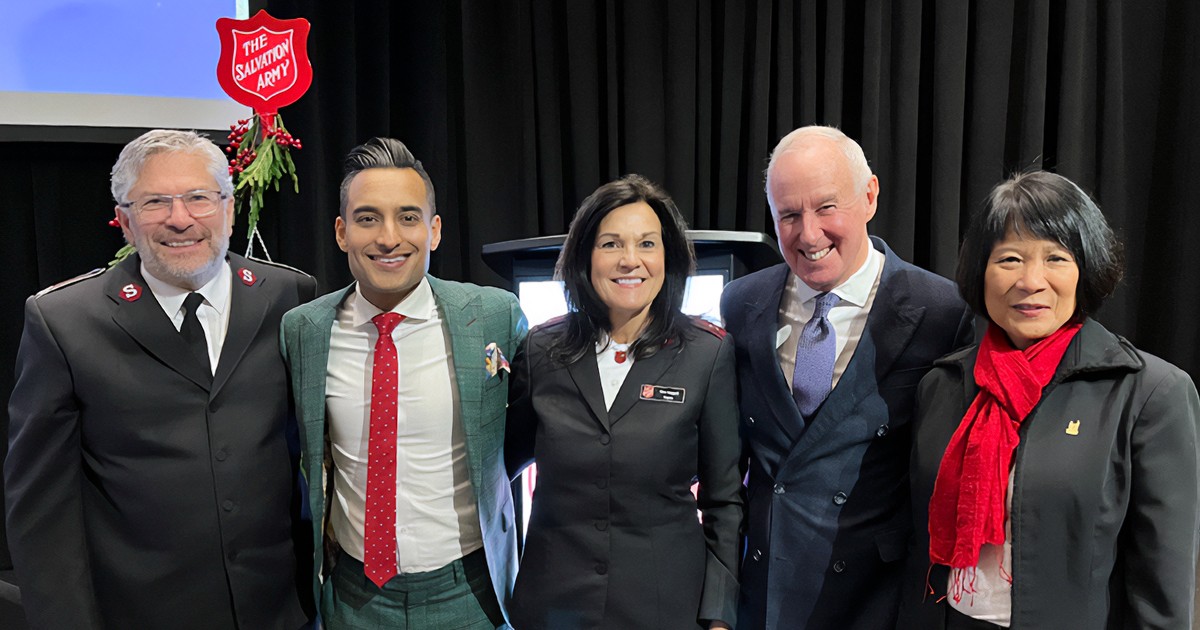Allow me to introduce you to Carol. She was a business professional who looked like she had everything; however, she was hiding a grim home life. Carol was the victim of physical, emotional and spiritual abuse at the hands of her husband. Through a connection with a corps, she met the corps officers. They recognized that Carol was being abused. While wanting to help, they also knew they couldn’t provide the care that she required. They connected her to a colleague trained in trauma-informed care.
As a result of trauma-informed ministry, Carol felt safe for the first time in 20 years. She gained the strength she needed to speak up to her husband and started to believe that she was not responsible for the abuse that had happened to her. She learned that she could make good choices in her life. After a violent incident, Carol took her children and left the marital home.
While she still has challenges, Carol now has the strength to say, “No more abuse,” to fight for custody of their four children and to begin planning for an abuse-free future. Her faith in humanity has started to improve and, more importantly, her faith in God has been restored.
WHAT IS TRAUMA?
Trauma is the lasting emotional response that often results from living through a distressing event. Exposure to a traumatic event or series of events harms a person’s sense of safety, sense of self and ability to regulate their emotions, and may cause difficulties in navigating relationships. The many effects of trauma can be immediate or delayed by weeks, months or years.
WHY DO WE NEED TRAUMA-INFORMED CARE?
Current Canadian statistics indicate that 70 percent of our population has experienced at least one traumatic incident, such as:
- Abuse
- Car, bus, train and plane accidents
- Natural disasters, pandemics
- Combat experiences
- Sudden unexpected death of loved ones
- Anything that makes a person fear for their or another’s safety
When we think about everyone connected to The Salvation Army—corps members, leaders, staff and clients at our social services centres—and realize that at least 70 percent of them have experienced trauma, we start to see the enormity of the situation. This statistic only accounts for reported incidents of trauma. The actual number is probably higher.
The Salvation Army is an organization that cares for people. Since most of the people we interact with have experienced trauma, we need to learn about trauma-informed care (TIC). It is my opinion that all Salvation Army ministries should be trauma informed.
WHAT IS TRAUMA-INFORMED CARE?
TIC is a way of relating to people that acknowledges the effects of trauma and, at the same time, tries not to retraumatize them. TIC has five principles.
- Trauma awareness and acknowledgment. This involves recognizing that a person has experienced trauma and that their behaviours and reactions are coping mechanisms that enable them to feel safer. These coping mechanisms are effective when the person is in danger, but the person will often react in the same way even when not in danger. The reason for this is that, fundamentally, a trauma survivor seldom feels safe. A trauma survivor mustn’t be forced to tell their story or explain what happened to them. When they choose to share something of what happened, they should always be believed, and their experience should be validated. We can say to them, “That must have been a terrible experience for you,” or “You have survived a lot,” or “What happened to you was not your fault.”
- Safety and trustworthiness. Since a trauma survivor does not feel safe, they also do not trust easily. Their world has been a dangerous place, and it is difficult for them to shift to believing that they are safe. It is important to try to make the person feel welcome and that they matter to you. Greeting someone warmly by their name is a simple way to do this. If the trauma experience has been one of abuse, the person will likely have been called many things but has rarely been warmly greeted by name. We need to be friendly and compassionate toward trauma survivors but also have appropriate boundaries.
- Choice, control and collaboration. TIC strives to give back choice to a person. We take for granted the ability to make choices. However, the trauma survivor, especially in cases of abuse, may need to learn this skill. They are used to being told what to do and are not used to making choices. Giving choice to the person may be as simple as allowing the person to choose where they want to sit in a meeting or select the food they receive from the food bank. Providing choice gives back some control to the person who may have previously experienced no control.
- Strength-based and skills-building care. One of the results of experiencing trauma is disempowerment. When a person is disempowered for a long time, they may learn to feel helpless. In reality, the person who has experienced trauma is resilient. Using a strength-based perspective, we see their resilience, coping skills and strength instead of viewing them as a victim with poor coping skills and weaknesses. Of course, the person may need to learn new life, social and employment skills, and many Salvation Army programs provide these learning opportunities. But from a strength-based perspective, we communicate our belief in the person and their ability to learn the required skills and make the necessary life changes. We may be the first to tell them that.
- Cultural, historical and gender issues. A word used to describe some people is marginalized. Marginalized populations may have additional challenges when seeking services due to social injustice and systemic barriers. Some will experience unequal opportunities and access to resources. Marginalized people may include:
- Women
- People with a disability
- The BIPOC (Black, Indigenous and Person of Colour) community
- The Latin American community
- The Middle Eastern community
- The LGBTQ2S+ community
- The immigrant/newcomer community
The more marginalizing factors, the more challenging it is for people to navigate life and achieve their goals. For example, a Latin American woman with a disability will find it more difficult to get her needs met than someone who is not marginalized. But even someone with one kind of marginalization will have challenges. A person who uses a walker or wheelchair will notice narrow doorways and boxes piled in aisles of stores, for example. An able-bodied person will easily adapt to these obstacles without a second thought. Is your program space accessible to all people?
TRAUMA-INFORMED CARE SHIFTS OUR THINKING FROM "WHAT IS WRONG WITH YOU?" TO "WHAT HAPPENED TO YOU?"
Some members of marginalized groups have experienced discrimination or systemic racism. This may have led to the effects of their trauma being passed down to future generations. The generations that follow carry the shame and other effects of trauma even if they did not experience the trauma themselves.
When people are struggling with the challenges of marginalization, trauma adds another layer of complexity and difficulty. But always remember that these challenges, while more layered, can be overcome with the resiliency inherent in all people.
TIC fits within the core values of The Salvation Army. Using the five principles of TIC in our interactions and service to others gives dignity and hope to the trauma survivor and helps them to feel safer. This leads to our interactions and programs being more successful and positive.
Training in TIC is available through the social mission department or through the TIC module in Fit for Mission.
MAJOR CATHERINE SKILLIN is a specialist, knowledge mobilization and implementation, in the social mission department.
This story is from:










Leave a Comment